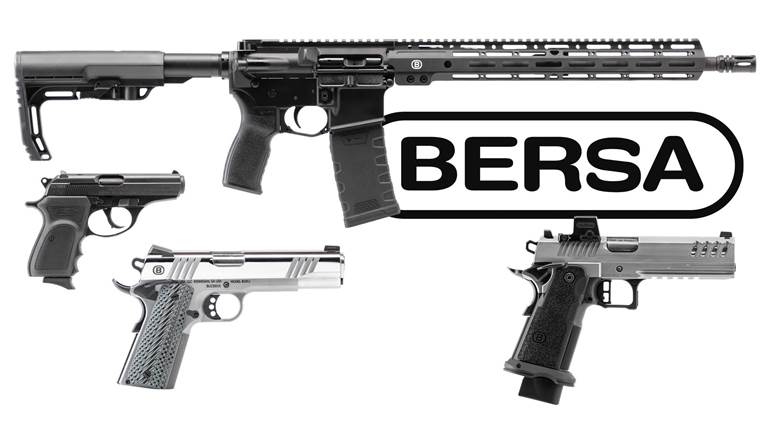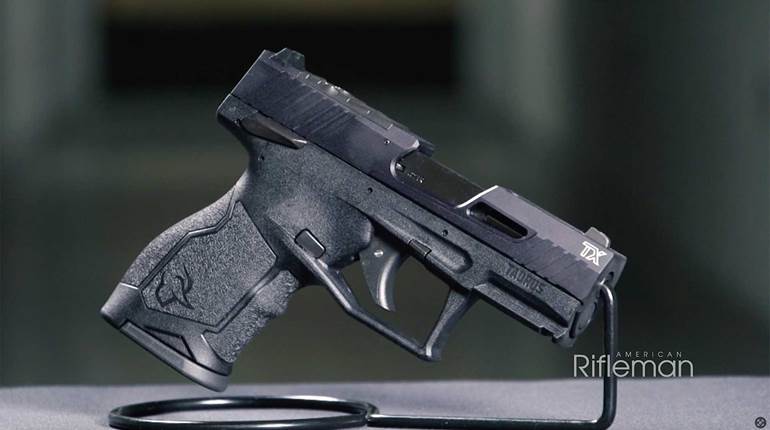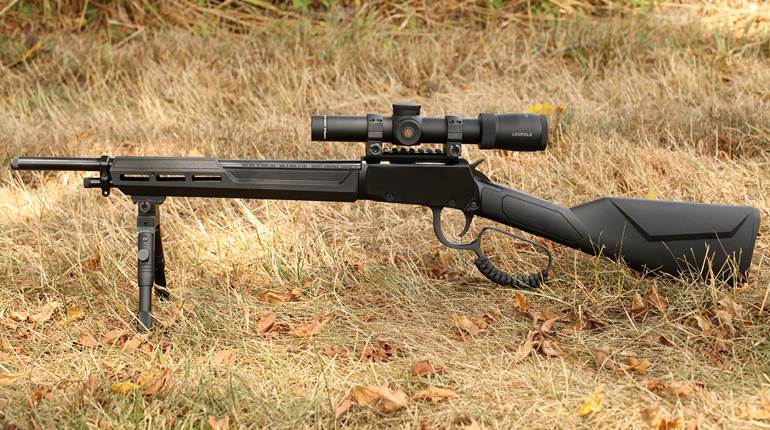
8/9/2012
Most shooters can think of at least one gun in their collection that's not quite the gun they had in mind, but they bought it anyway. For me, it's a Glock Gen 3 G23C that I've had for a few years now. The pistol was discovered in as-new condition, with all of the original packaging and bits present. My fondness for Glock pistols, my desire for a compact in .40 S&W, and a jaw-droppingly low price all combined to generate a gravitational pull to yank a major credit card out of my wallet and directly into the cash register.
The G23C is one of those well balanced, all-purpose pistols that is large enough to shoot comfortably, but compact enough for concealed carry. The 13+1 capacity and .40 S&W chambering offer plenty of power for personal and home protection. Because it's a Glock, it is lightweight and reliable. So what's not to love? The "C" in the model designation for this pistol stands for compensated. Two slot-shaped holes, or ports, with corresponding cuts in the slide, allow the gases produced by the fired cartridge to escape upwards through the barrel to reduce muzzle rise.
The benefits of shooting a ported pistol are perceived reduction in felt recoil and quicker re-acquisition of the target for faster follow-up shots. This is useful for competitive shooting or for those who are sensitive to recoil. However, the softer shooting characteristics of barrel porting can pose some problems for defensive applications. First, the ports make the pistol much louder, which is rarely a desirable feature. Secondly, the hot gasses released from the top of the slide have the potential of harming the shooter. Just imagine shooting from the hip or from a close-ready position and it becomes evident that the ports can quickly turn into a permanent hair removal system. Finally, the ports reduce bullet velocity, as a bullet stops gaining velocity as soon as it passes the ports. Since the ports in the G23 barrel start about 1.5 inches from the muzzle, they effectively reduce the velocity potential of the pistol from that of a 4.02-inch barrel to that of a 2.5-inch barrel. Again, for defensive applications, it makes sense to hold on to as much velocity as possible.
The most cost effective solution to the problem of the G23C's porting was to search out a replacement barrel. This would be far less expensive than buying a new pistol and the ported barrel would still be on hand if needed. One of the best suppliers of after-market Glock parts is Lone Wolf Distributors. Not only does it provide factory and after-market parts for repairs, it offers a wide variety of in-house products for upgrading, converting and customizing Glock pistols. As I looked over its catalog of components, I realized that a non-ported barrel for the G23 was just the tip of its inventory iceberg.
Barrel & Magazine-Only Caliber Conversions
One of the reasons Glocks are popular for at-home gunsmithing is the pistol's modularity. It's relatively easy to swap out most of the pistol’s components without the need for complex tools or permanent modifications. The G23, chambered in .40 S&W, shares a good deal in common with the model G19 (9mm) and the G32 (.357 Sig). All three pistols use the same frame and recoil assembly, so converting between these three calibers only requires the correct barrel and magazine.
Please note that because the diameter of the G23's native .40 S&W barrel is slightly larger than that of a factory G19 9 mm barrel, the G19 barrel is too small to operate in the G23. Lone Wolf solves this problem by providing a series of 40-9 barrels, which provide the correct diameter needed to fire 9 mm cartridges using the G23 slide. Don't forget to order the correct magazines for the caliber you are converting to. Some believe they can get away with using the .40 S&W magazines to fire 9 mm cartridges through a 40-9 barrel. However, Lone Wolf points out that mixing magazine and barrel calibers is not always successful, resulting in jams and failures to feed. The best solution is to buy magazines stamped with the same caliber designation as the barrel.
For this simple conversion, I was most interested in finding out how the G23C would perform with a non-ported Lone Wolf stainless-steel barrel. The total cost for the upgrade was just $109.95, since the barrel was the only new part required. Prior to ordering the barrel, I had already replaced the factory polymer three-dot sights with Trijicon’s new HD night sights.
Shooting five-shot groups from the bench at 25 yards, the barrel provided solid accuracy and reliability. Groups ranged from 2.75 inches to 3.5 inches. With no malfunctions produced by either practice grade or hollow point ammunition, I would say the G23 is ready to go to work as a defensive handgun with this Lone Wolf barrel installed.
G23 "Long Slide" Caliber Conversion
For fans of long-slide pistols it was happy news when Lone Wolf released its new dust cover component this year. This small, U-shaped, stainless-steel insert fills the gap between a Compact size recoil assembly and the recoil assembly connector of a Standard size slide. In other words, the Compact 7.36-inch slide of the G23 can be traded out for an 8.06-inch slide while still using the Compact recoil assembly. This gives the shooter the advantages of the longer barrel and sight radius of a Standard size Glock while providing the shorter grip profile of the Compact G23.
Lone Wolf slides are sold "bare," meaning they do not contain any of the pins or springs needed for the pistol to operate. This allows customers to pick and choose the internal components and sight system they prefer. For this review, a Lone Wolf G22 stainless-steel slide was combined with a 4.49-inch LWD M/32 stock-length barrel chambered in .357 Sig. The bare slide with the barrel cost about $285 dollars. Other costs depend on the sights and the slide parts selected, and whether or not the customer opts to pay a small service charge to have the components installed by Lone Wolf. In this case, the internal slide components were a blend of Lone Wolf in-house parts and Glock factory components. The recoil assembly consisted of a Lone Wolf stainless-steel guide rod with a 20-pound flat wire spring. The two external custom touches include an engraved slide cover plate and an adjustable Elliason-style rear target night sight from Champion Sights.
With the dust cover and .357 Sig slide assembly in place, the modified G23 proved to be both reliable and fun to shoot. The stainless-steel finish and increased length of the slide gave the pistol a handsome two-tone profile. The pistol exhibited the balance and feel that make the standard-size Glock pistols such a popular option. Using the same formal accuracy testing techniques as with the .40 S&W barrel, this Lone Wolf upper provided a best single five-shot group of 2.5 inches, and a best group average of 2.9 inches with Hornady's soft-shooting Critical Defense .357 Sig 115-grain FTX load. With the low profile target night sights in place, this slide can comfortably move between target shooting and self-defense applications.
Custom Slide Caliber Conversion
Lone Wolf's custom shop is adept at dressing up any plain-Jane Glock and making it a one-of-a-kind pistol. In this case, a G23 slide was extensively engraved and rounded along the rear edges to provide both exceptional appearance and added functionality. The deep grooves and dots cut from the top and sides of the slide look very slick, but they also work to lighten the slide and to provide added texture for a more positive gripping surface. After the engraving was completed, the slide was treated with a matte black oxide finish and topped off with the new Ameriglo Combative Applications Pistol (CAP) sight system. The internal slide components also included some of Lone Wolf's most recent offerings, such as its new lightweight firing pin, firing pin safety and marine spring cups. This level of customization requires a conversation with the folks at Lone Wolf in order to determine the pricing.
To complement the slide, a Lone Wolf threaded 40-9 barrel was installed. Lone Wolf's threaded barrels protrude .6 inches past the muzzle end of the slide to allow for the attachment of barrel accessories like muzzle breaks, flash hiders and sound suppressors. Just like the other stainless steel barrels built by this company, the 40-9 contains traditional rifling that can safely fire lead bullets. If you want to use the barrel without any accessories attached, knurled thread-protector rings in a black or silver finish are available. For this review, testing was conducted with a LW 40-9 flash hider attached, which increased the positive feedback from the other shooters on the range. It shot flawlessly as well. To accommodate the reduced recoil of the 9 mm cartridge and the lighter slide, the stainless-steel recoil rod contained a 15-pound flat wire recoil spring.
Lone Wolf Distributors provide shooters with a distinctive set of products for Glock pistols. Whether you are searching for defensive, competition or even hunting upgrades, this company has something in stock for you. Enjoy the opportunity to conduct a do-it-yourself upgrade, or let the folks at Lone Wolf do the work for you. Change out the entire slide assembly, or just drop in a new barrel. Whatever you choose to do, you can expect to receive high-quality components and top-notch customer service as well.
View the Lone Wolf Distributors' Caliber Conversions Photo Gallery





































